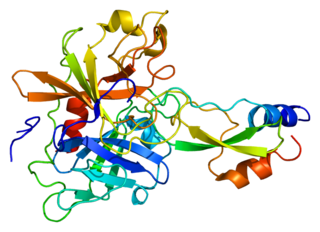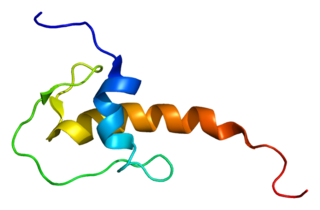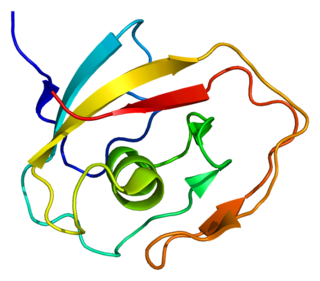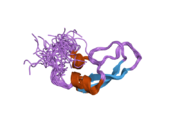
Pancreatic secretory trypsin inhibitor (PSTI) also known as serine protease inhibitor Kazal-type 1 (SPINK1) or tumor-associated trypsin inhibitor (TATI) is a protein that in humans is encoded by the SPINK1 gene.

Kunitz-type protease inhibitor 1 is an enzyme that in humans is encoded by the SPINT1 gene.

Glia-derived nexin is a protein that in humans is encoded by the SERPINE2 gene.

Lympho-epithelial Kazal-type-related inhibitor (LEKTI) also known as serine protease inhibitor Kazal-type 5 (SPINK5) is a protein that in humans is encoded by the SPINK5 gene.

Wnt inhibitory factor 1 is a protein that in humans is encoded by the WIF1 gene. WIF1 is a lipid-binding protein that binds to Wnt proteins and prevents them from triggering signalling.

Hepatocyte growth factor activator is a protein that in humans is encoded by the HGFAC gene.

Reversion-inducing-cysteine-rich protein with kazal motifs, also known as RECK, is a human gene, thought to be a metastasis suppressor.

Procollagen C-endopeptidase enhancer 1 is an enzyme that in humans is encoded by the PCOLCE gene.

A disintegrin and metalloproteinase with thrombospondin motifs 8 is an enzyme that in humans is encoded by the ADAMTS8 gene.

Follistatin-related protein 1 is a protein that in humans is encoded by the FSTL1 gene.

WAP four-disulfide core domain protein 5 is a protein that in humans is encoded by the WFDC5 gene.

Paired immunoglobulin-like type 2 receptor beta is a protein that in humans is encoded by the PILRB gene.

Eppin is a protein that in humans is encoded by the SPINLW1 gene.

WAP four-disulfide core domain protein 1 is a protein that in humans is encoded by the WFDC1 gene.

Serine protease inhibitor Kazal-type 2 also known as acrosin-trypsin inhibitor is a protein that in humans is encoded by the SPINK2 gene.

Lympho-epithelial Kazal-type related inhibitor 2 (LEKTI-2) is a protein encoded by the SPINK9 gene in humans. LEKTI-2 is an inhibitor of KLK5, a serine protease expressed in the epidermis and responsible for coordinating skin homeostasis and desquamation. SPINK9 is a member of a gene family cluster located on chromosome 5q33.1, which includes SPINK5 and SPINK6.

In molecular biology, the LCCL domain is a protein domain which has been named after several well-characterised proteins that were found to contain it, namely Limulus clotting factor C, Cochlin (Coch-5b2) and Lgl1 (CRISPLD2). It is an about 100 amino acids domain whose C-terminal part contains a highly conserved histidine in a conserved motif YxxxSxxCxAAVHxGVI. The LCCL module is thought to be an autonomously folding domain that has been used for the construction of various modular proteins through exon-shuffling. It has been found in various metazoan proteins in association with complement B-type domains, C-type lectin domains, von Willebrand type A domains, CUB domains, discoidin lectin domains or CAP domains. It has been proposed that the LCCL domain could be involved in lipopolysaccharide (LPS) binding. LCCL exhibits a novel fold.

Protease, serine, 3 is a protein that in humans is encoded by the PRSS3 gene.

WAP, follistatin/kazal, immunoglobulin, kunitz and netrin domain containing 2 is a protein that in humans is encoded by the WFIKKN2 gene.

Paired immunoglobin like type 2 receptor alpha is a protein that in humans is encoded by the PILRA gene.
























